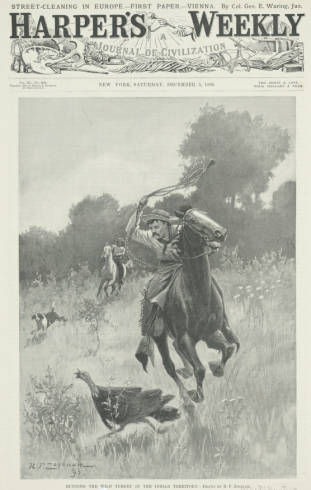November
Turkeys

The Turkey
This old road is hard and bumpyOur new turkey's wild and jumpy.
Careful, driver, not so jerky
Or you'll make us spill our turkey.
Oklahoma's Wild Turkeys
Some farmers grew turkeys on their farms in 1907, the year Oklahoma became a state, but most people probably went out hunting for wild turkey for their Thanksgiving tables. In fact, wild turkeys were nearly wiped out in the early days of statehood because of the influx of people. By 1925, most people thought they were extinct. In the late 1940s the Oklahoma Department of Wildlife Conservation embarked on a stocking program to reestablish the wild turkey to its former range. This program was so successful that today we have huntable populations in every county.
 Running the Wild Turkey in Indian Country, 1896 (Harper's Magazinecover)
Running the Wild Turkey in Indian Country, 1896 (Harper's Magazinecover)
- Smart Board Acitivities
(Need help?)Please be patient with us as we learn how to use this new technology.
You must have Smart Notebook software installed on your computer to open Smart Board activities. If you have Smart Notebook software and are using Internet Explorer, you may get a message telling you the activity cannot be opened. In this event, save the activity to your hard drive. Your browser will save it as a zip file. Simply change the "zip" in the file name to "notebook," and you should be able to open it.
Thank you for your patience.
Smart Board Acitivity page
Although bison had been all but exerminated on the Southern Plains by the 1880s, other populations of wild game were relatively plentiful. In Rufus F. Zogbaum's "Running the Wild Turkey in the Indian Territory," a hunter armed with a lasso rides after a large bird flushed from the trees. Hunting for sport became popular in the territories in the 1890s. (from "Picturing Indian Territory," special exhibition at Fred Jones Museum of Art, Norman)
Hunting Turkey in the Territory
Early in the morning, the spring followed the opening, we often heard the "gobble, gobble" of a wild turkey a short distance from our claim. Desiring to add to the family larder, I had the old gun loaded with coarse shot ready for the next warning. Sure enough, a few days later Father called me about daybreak saying "The old gobbler is calling you." Hopping out of bed, scantily clad, I grabbed the gun and started toward the object of my quest. Knowing the terrain of the land, I judged the bird was near a gully, from which a close approach was possible. Soon I came near the object of my search. I waited for his "gobble, gobble" and located an object moving through the half burnt grass and scrub oak. Feeling sure it was the turkey I took aim and fired. Climbing from the pit, I was horrified to see a man standing where I believed the turkey was strutting. I ran up to him and asked if he was hurt. Lowering his trousers, we observed small trickles of blood from the gun shot wounds. My aim was perfect for the intended victim. He replied that he did not think that the shot was serious, however. I offered to get a doctor but he declined. Unknown to each other, both of us were stalking the turkey, which escaped unharmed.
Stiles, George W., "Early Days in the Sac and Fox Country," Oklahoma Territory, Chronicles of Oklahoma, Vol. 033, p. 316, http://digital.library.okstate.edu/Chronicles/v033/v033p316.pdf
Turkeys and the Pilgrims
"Turkeys were by no means a novelty to the Pilgrims. When the conquistadors arrived in Mexico in the sixteenth century, they discovered that the Indians of Central America possessed domesticated turkeys as well as gold. The birds were imported to Spain as early as the 1520s, and by the 1540s they had reached England. By 1575, the domesticated Central American turkey had become a fixture at English Christmases. The wild turkey of New England was bigger and much faster than the birds the Pilgrims had known in Europe and were often pursued in winter when they could be tracked in snow."
from Philbrick, Nathaniel, Mayflower, Penguin, 2006.
Benjamin Franklin on the Turkey
"...Others object to the Bald Eagle as looking too much like a Turkey. For my own part, I wish the Bald Eagle had not been chosen as the Representative of our Country; he is a Bird of bad moral Character. For in truth, the Turkey is in comparison a much more respectable Bird, and withal a true original Native of America. Eagles have been found in all Countries, but the Turkey was peculiar to ours...He is, though a little vain and silly, it is true, but not the worse emblem for that, a Bird of Courage, and would not hesitate to attack a Grenadier of the British Guards, who should presume to invade his Farmyard with a red coat on."
- Benjamin Franklin
What makes dark meat dark?
Dark meat, which avian myologists (bird muscle scientists) refer to as "red muscle," is used for sustained activity—chiefly walking, in the case of a turkey. The dark color comes from a chemical compound in the muscle called myoglobin, which plays a key role in oxygen transport. White muscle, in contrast, is suitable only for short bursts of activity such as, for turkeys, flying. That's why the turkey's leg meat and thigh meat are dark, and its breast meat (which makes up the primary flight muscles) is white. Other birds more capable in the flight department, such as ducks and geese, have red muscle (and dark meat) throughout.
A 3-ounce serving of skinless white turkey meat contains 25 grams of fat, and less than 1 gram of saturated fat. Dark meat has more saturated fat than white meat, and eating the skin adds even more saturated fat. Turkey is also a good source of arginine—an amino acid the body uses to make new protein and nitric oxide, the substance that relaxes and opens arteries. (Source: Harvard Health Publications)
